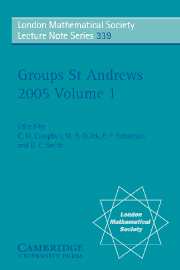Book contents
- Frontmatter
- Contents
- Introduction
- Aspects of infinite permutation groups
- Self-similarity and branching in group theory
- On surface groups: motivating examples in combinatorial group theory
- Nilpotent p-algebras and factorized p-groups
- Classification of finite groups by the number of element centralizers
- Algorithmic use of the Mal'cev correspondence
- Minimal but inefficient presentations for semi-direct products of finite cyclic monoids
- The modular isomorphism problem for finite p-groups with a cyclic subgroup of index p2
- On one-generated formations
- New results on products of finite groups
- Radical locally finite T-groups
- Explicit tilting complexes for the Broué conjecture on 3-blocks
- Conjugacy classes of p-regular elements in p-solvable groups
- An algorithm for the unit group of the Burnside ring of a finite group
- Integral group ring of the first Mathieu simple group
- Embedding properties in direct products
- Malcev presentations for subsemigroups of groups — a survey
- Finite groups with extremal conditions on sizes of conjugacy classes and on degrees of irreducible characters
- Conjugacy class structure in simple algebraic groups
- On automorphisms of products of groups
- Linear groups with infinite central dimension
- G-automata, counter languages and the Chomsky hierarchy
- An embedding theorem for groups universally equivalent to free nilpotent groups
- Irreducible word problems in groups
- Recent growth results
On automorphisms of products of groups
Published online by Cambridge University Press: 07 May 2010
- Frontmatter
- Contents
- Introduction
- Aspects of infinite permutation groups
- Self-similarity and branching in group theory
- On surface groups: motivating examples in combinatorial group theory
- Nilpotent p-algebras and factorized p-groups
- Classification of finite groups by the number of element centralizers
- Algorithmic use of the Mal'cev correspondence
- Minimal but inefficient presentations for semi-direct products of finite cyclic monoids
- The modular isomorphism problem for finite p-groups with a cyclic subgroup of index p2
- On one-generated formations
- New results on products of finite groups
- Radical locally finite T-groups
- Explicit tilting complexes for the Broué conjecture on 3-blocks
- Conjugacy classes of p-regular elements in p-solvable groups
- An algorithm for the unit group of the Burnside ring of a finite group
- Integral group ring of the first Mathieu simple group
- Embedding properties in direct products
- Malcev presentations for subsemigroups of groups — a survey
- Finite groups with extremal conditions on sizes of conjugacy classes and on degrees of irreducible characters
- Conjugacy class structure in simple algebraic groups
- On automorphisms of products of groups
- Linear groups with infinite central dimension
- G-automata, counter languages and the Chomsky hierarchy
- An embedding theorem for groups universally equivalent to free nilpotent groups
- Irreducible word problems in groups
- Recent growth results
Summary
Abstract
When the finite group G can be written as a product G = PQ (a direct, semidirect, or central product), with Q ⊲ G, we investigate the extent to which Aut(P) and Aut(Q) figure in the structure of Aut(G). In particular, we study the image of the map p : Aut(G;Q) → Aut(G/Q) × Aut(Q), where Aut(G;Q) is the subgroup of automorphisms of G that restrict to automorphisms of Q.
Introduction
In this study, we are interested in the relationships among Aut(G) and the automorphisms of subgroups and subquotients of G. In particular, if G = PQ we would like to understand the extent to which Aut(P) and Aut(Q) figure in the structure of Aut(G). There is, a priori, no reason to believe that Aut(P) and Aut(Q) have any influence on Aut(G), but, indeed, there are conditions under which the influence can be both felt and described.
In the case that G = P × Q, the relationship among Aut(P), Aut(Q), and Aut(G) is easy to discern when one of P or Q is characteristic. More generally, there are conditions under which information on Aut(G/ Φ (G)) can be obtained from understanding the automorphisms of P, Q, or their Frattini quotients. For some algebraic topologists, this latter kind of information suffices for gaining knowledge about the stable homotopy decomposition of the classifying spaces of direct products of groups (see [3] and [6]).
- Type
- Chapter
- Information
- Groups St Andrews 2005 , pp. 288 - 305Publisher: Cambridge University PressPrint publication year: 2007
- 4
- Cited by



